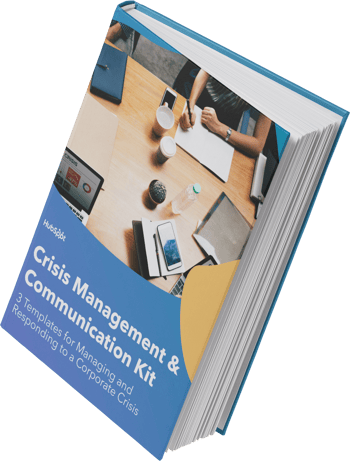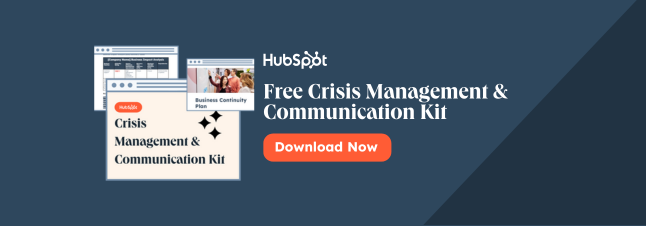Nobody plans their mistakes, they just happen. And, they often happen at the worst possible time. While no one wants to anticipate failure, it's important that your business is ready to handle multiple types of crises should they ever occur.

Most of us want to fix things as soon as possible, but when your business messes up, it's not always easy to notice or resolve. Little mistakes can quickly snowball into a costly endeavor that your team didn't see coming. Whether it was your fault or not, small issues can quickly get out of hand until they've escalated to a full-on crisis.
To effectively deal with business crises, your team will need to know:
What is a business crisis?
A business crisis occurs when an unexpected problem puts the stability of a company or organization at risk. These dilemmas can either originate internally or they can be brought on by external influences. The problem affecting the business escalates to the point where it's out of the company's control and they can't resolve it. If left unaddressed, this issue may permanently damage the business or cause it to fail.
.png)
Crisis Communication and Management Kit
Manage, plan for, and communicate during your corporate crises with these crisis management plan templates.
- Free Crisis Management Plan Template
- 12 Crisis Communication Templates
- Post-Crisis Performance Grading Template
- Additional Crisis Best Management Practices
The easiest way to identify a business crisis is to assess the problem for three key elements.
- First, the problem must pose an imminent threat to the organization.
- Next, the situation must involve an element of surprise or shock.
- Finally, due to the severity of the problem as well as its unexpected nature, the situation will place pressure on the business to make timely and effective decisions. Knowing the elements that make up a business crisis can be instrumental in identifying these problems before it's too late.
However, sometimes crises are unavoidable, making it imperative that your business has a response ready to handle conflicts. Adopting a crisis management team is a great way for a company to proactively prepare for crises.
These teams are in charge of anticipating potential problems and making key decisions to resolve strenuous situations. Successful crisis management teams understand the different types of business crises and are thoroughly prepared for all situations.
Download the Crisis Management & Communication Kit
Types of Crisis
- Financial Crisis
- Personnel Crisis
- Organizational Crisis
- Technological Crisis
- Natural Crisis
- Confrontation Crisis
- Workplace Violence Crisis
- Crisis of Malevolence
Business crises can manifest in many forms, so your team will need to be prepared to handle a variety of unique situations. Your team should ready a range of responses that are each tailored to address a different type of crisis. To help your team get started, we went ahead and compiled a list of the different types of crisis that any business could face.
1. Financial Crisis
A financial crisis occurs when a business loses value in its assets and the company can't afford to pay off its debt. Typically, this is caused by a significant drop in demand for the product or service.
In these cases, the company must move funds around to cover immediate short-term costs. Then, they'll need to reanalyze their revenue sources to look for new ways to generate long-term income as well as increase their margins.
Examples of a Financial Crisis
Delta Air Lines: Delta Air Lines filed for bankruptcy in 2005. Customer demand had decreased due to the September 11 attacks, and this trend continued into the mid-2000s. The company overcame bankruptcy in 2007 and invested in its workforce to improve the customer experience. In 2020, it created a profit-sharing program and paid out nearly $1.6 billion in profit shares to its employees.
Gold’s Gym: In the wake of all the closures and movement restrictions in 2020, fitness giant Gold’s Gym filed for bankruptcy and permanently closed around 30 gyms. It recovered from this crisis after RSG Group acquired them in July of 2020.
2. Personnel Crisis
Personnel crises occur when an employee or individual who's associated with the company is involved in unethical or illegal misconduct.
Whether it's within the workplace or an employee's personal life, these situations can result in a serious backlash against the company. Since the organization employed or supported this individual, its lack of judgment is reflected onto the company's reputation.
In these cases, you'll need to identify the scope of the situation, determine appropriate disciplinary action, and if necessary, provide a written or verbal statement. It's important to first fully evaluate the situation and determine how severely the individual violated your company's values.
This will help you determine the right responsive action to take against the convicted individual. Finally, if this situation has drawn media attention, you'll want to be transparent to these outlets and inform them about the actions you're taking.
Examples of a Personnel Crisis
Tyson Foods: The pandemic put a strain on just about everything — including our food supply chain. Workers at a Tyson Foods pork plant in Iowa found themselves working longer hours to keep up with demand, and in close quarters. As a result, COVID-19 quickly spread and several workers died after contracting the virus.
Making matters worse, supervisors at the Waterloo, Iowa plant were allegedly involved in a betting pool guessing how many workers would get sick from the virus. Not only did this come across as cruel and callous, but the company is now facing legal repercussions as families of the deceased have filed lawsuits.
WeWork: One of the most compelling examples of a personnel crisis is the 2019 WeWork scandal. Adam Neumann, WeWork’s former CEO, stepped down after overvaluing the company (lying about how much the company was worth) when the firm attempted to go public.
CrossFit: During the height of the 2020 Black Lives Matter movement, CrossFit’s former CEO, Greg Glassman, said in a meeting that “he didn’t mourn George Floyd’s death.” He also alleged that racism and police brutality were not systemic problems. After issuing an apology, he stepped down.
.png)
Crisis Communication and Management Kit
Manage, plan for, and communicate during your corporate crises with these crisis management plan templates.
- Free Crisis Management Plan Template
- 12 Crisis Communication Templates
- Post-Crisis Performance Grading Template
- Additional Crisis Best Management Practices
3. Organizational Crisis
Organizational crises are situations where the company has significantly wronged its consumers or employees. Rather than creating mutually beneficial relationships, these businesses use their customers as a means of benefiting the company, or abuse their employees to “save face.”
The three types of organizational crises are:
- Crisis of Deception: This type of crisis occurs when a company knowingly lies about public-facing product information or tampers with public-facing data.
- Crisis of Management Misconduct: This type of crisis is a result of management willingly and knowingly engaging in illegal activities.
- Crisis of Skewed Management Values: This type of crisis results when senior leadership emphasizes short-term financial gains over social responsibility and neglects the interests of stakeholders such as customers and employees.
Examples of misconduct include withholding information, exploiting customers, and misusing managerial powers.
Changing company culture is the best way to address organizational crises because these problems are typically caused by employees who neglect customer needs. Embracing an organizational culture that's dedicated to customer success can reduce the chances of encountering an internal crisis. Additionally, you should proceed to hire employees who are closely aligned with your company's values.
Examples of an Organizational Crisis
Google: In late 2020, Google faced allegations of spying on employees and discouraging unionized organizations. The firm “illegally surveilled” employees’ discussions when they aired their workplace grievances.
Google made a public statement to The Verge, saying, “We’re proud of [our] culture and are committed to defending it against attempts by individuals to deliberately undermine it. [...] Such actions are a serious violation of our policies and an unacceptable breach of a trusted responsibility, and we will be defending our position.”
Wells Fargo: To meet sales quotas, Wells Fargo’s employees illegally opened millions of fake customer accounts without the customers’ consent. Employees falsified signatures and created fake records that resulted in billions of dollars in revenue. In 2020, Wells Fargo paid a settlement of $3 billion to cover the corporate penalties incurred.
Crisis Management Kit
Fill out the form for your free templates.
4. Technological Crisis
In today's tech-driven age, businesses heavily rely on technology to perform day-to-day functions. So, when that technology crashes, they have a lot more to worry about than a few missing emails. Ecommerce sites and software companies can lose millions of potential leads if their servers suddenly break. That's not only a huge loss of potential revenue, but it's also a major hit to the product or service's reputation.
The first step to managing these crises is to work with your IT or tech provider to resolve the issue immediately. Your primary concern should be to prevent the issue from affecting any more customers.
Once your software is back online, the next step is to work with your internal resources to determine what happened to your system and set up safeguards to prevent it from occurring again. Boost up your customer service and customer support teams to make sure they're ready to handle a sudden spike in calls from angry or confused customers.
Examples of a Technological Crisis
Google: In December 2020, a major product outage affected most of Google’s offerings and services, including Gmail, YouTube, and other Google Workspace products. Google offers an up-to-date public dashboard with its systems’ status, and it used this tool to keep users up-to-date during the outage.
In an email to Google’s customers, a spokeswoman wrote, “Today, at 3:47 AM PT, Google experienced an authentication system outage for approximately 45 minutes due to an internal storage quota issue. All services are now restored. We apologize to everyone affected, and we will conduct a thorough follow up review to ensure this problem cannot recur in the future.”
Instagram: In March 2021, Instagram, WhatsApp, and Facebook Messenger went down for at least an hour for thousands of users. While this mainly impacted everyday consumers, international businesses that use WhatsApp and Messenger to connect with clients were left adrift.
Facebook issued a response to The Verge, saying, “Earlier today, a technical issue caused people to have trouble accessing some Facebook services. We resolved this issue for everyone, and we apologize for any inconvenience.” The services were restored on the same day.
5. Natural Crisis
If an earthquake destroys your office, you might call that a crisis. While it may be rare, natural disasters like hurricanes, earthquakes, and tornados can make a significant impact on your business. If your company is located in an area that's exposed to extreme weather, you'll need to prepare an emergency response in the unfortunate event that you're affected.
The best way to handle natural crises is to be proactive. Build your office in a structure that's resilient to weather in your area and prepare an evacuation plan in the event of an emergency. It will also help to prepare a contingency plan for business operations in case your offices become unavailable.
.png)
Crisis Communication and Management Kit
Manage, plan for, and communicate during your corporate crises with these crisis management plan templates.
- Free Crisis Management Plan Template
- 12 Crisis Communication Templates
- Post-Crisis Performance Grading Template
- Additional Crisis Best Management Practices
Examples of a Natural Crisis
COVID-19: The COVID-19 pandemic impacted not only businesses but organizations and families alike. While it took the world by surprise, many businesses built remote work and/or health protocols into their operating model to keep employees and customers as safe as possible.
California Wildfires: The 2020 California Wildfiresravaged the West Coast and resulted in over 10,000 structures getting damaged or destroyed. During the California fire season, it’s important to follow CAL FIRE’s wildfire preparedness documentation and educate oneself on how to reduce wildfire risk.
Devastating Tornadoes: In December of 2021, deadly tornadoes ripped through parts of Kentucky, Illinois, and Tennessee. As the death toll climbed, Amazon and Mayfield Consumer Products — which operated factories in the impacted areas — quickly came under scrutiny for their handling of the emergency.
The candle factory operated by Mayfield Consumer Products was completely leveled from the tornado. With reports of at least 8 deaths, employees and their family members started speaking out about allegedly not being able to leave after tornado warnings were issued.
Amazon was not spared either, as news surfaced that one of their drivers was forced to continue making deliveries during the tornado or face termination. Additionally, 6 workers at their Illinois warehouse died when a tornado tore through it. Amazon has stated that the employees who died were not in the warehouse’s designated assembly area, OSHA is investigating the matter.
6. Confrontation Crisis
A confrontation crisis can arise in any number of ways. Your employees may fight. A disagreement may spiral out of control amongst senior leadership. Or, public discontent with your firm can result in a public outcry.
In all cases, the parties involved are looking to get their demands met. This may result in a public boycott or resignations en masse.
To handle a confrontation crisis, first validate the concerns of those who are confronting you. It’s important to recognize that if they were led to this point, the issue must be significant. Next, review the demands, if any, that the parties have issued. Can you affect change that results in those demands being met? If not, then carefully and tactfully state the reason you can’t.
If the confrontation crisis is happening internally, use conflict resolution skills to defuse the situation before it escalates further.
Examples of a Confrontation Crisis
Hollywood Foreign Press Association: In 2021, the Hollywood Foreign Press Association faced a boycott because of the lack of diversity and inclusion in the organization. More than 100 of Hollywood’s publicity firms said that they’ll tell their clients, most of whom are famous stars, to not attend the Golden Globes or other HFPA events unless the organization is reformed.
In a public statement, the HFPA said, “As a demonstration of our commitment, the board has unanimously approved a plan to increase membership to a minimum of 100 members this year, with a requirement that at least 13% of the membership be Black journalists.”
Target: In early 2021, a California Target location was subject to a protest after the store’s security wrongfully accused three Black teens of shoplifting. According to The Los Angeles Times, Target issued a public apology, saying that it “fired a security staffer and would require that other employees at the store retake mandatory security and racial bias training.”
7. Workplace Violence Crisis
A workplace violence crisis occurs when a current or former employee commits violence against other employees. Unfortunately, these crises can come on suddenly, and it could be difficult to act before it escalates further or becomes fatal.
The best course of action, especially when de-escalation isn’t possible, is to involve law enforcement as quickly as possible. If an employee was harmed, send the employee immediately to the nearest hospital to get medical help.
Examples of a Workplace Violence Crisis
Molson Coors: In February 2020, a Molson Coors brewery employee brought a gun to the workplace and opened fire, killing five people. Gavin Hattersley, Molson Coors’ chief executive, said in a statement, “I am devastated to share that we lost five other members of our family in this tragic incident. There are no words to express the deep sadness many of us are feeling right now.”
Valley Transit Authority: In May of 2021 in San Jose, California, nine Valley Transit Authority (VTA) employees were shot and killed by a fellow co-worker. Sam Cassidy, 57, burst into a morning meeting at the rail yard and opened fire on his colleagues before killing himself.
Investigators later found that Cassidy had harbored hatred towards his co-workers for years with his ex-wife reporting that he had talked about killing his co-workers in the past. VTA later released notes which included Cassidy’s personnel files that showed he had a prior incident of insubordination and a verbal altercation with a colleague, but nothing to suggest he was a danger to anyone’s safety.
Popeyes: At a Popeyes in Florida, four women violently attacked a drive-thru worker through the window. While Popeyes did not make a public statement about the incident, it immediately involved law enforcement, and three of the women were arrested in March 2021.
.png)
Crisis Communication and Management Kit
Manage, plan for, and communicate during your corporate crises with these crisis management plan templates.
- Free Crisis Management Plan Template
- 12 Crisis Communication Templates
- Post-Crisis Performance Grading Template
- Additional Crisis Best Management Practices
8. Crisis of Malevolence
A crisis of malevolence occurs when a firm’s opponents use criminal or illegal means to destabilize a firm, harm its reputation, extort it, or even destroy it. Examples include tampering with a company’s product to create large-scale harm, using a company’s products in illegal or unaccepted ways, or hacking into a company’s system to steal encrypted data.
General examples of this type of crisis include cybersecurity threats, hacking, kidnapping, spreading of false rumors, and product sabotage — all with the objective of harming an organization, its stakeholders, and its public image.
When dealing with a crisis of malevolence, first secure your employees’ and customers’ safety — whether by involving law enforcement, patching a cybersecurity risk, or recalling a product that has been tampered with. Next, address the perpetrators, when possible, through legal means.
Examples of a Crisis of Malevolence
Cow & Gate and Tesco: In 2020, the food manufacturer Cow & Gate experienced a crisis of malevolence after its baby food jars were subject to tampering. In response, it immediately recalled the affected products, and in late 2020, a man was apprehended and charged with the crime.
Accellion: In December 2020, Accellion, a file transfer service, was subject to a sophisticated hacker attack that exposed data from several organizations, including Harvard and Kroger. The attack exposed the Social Security Numbers of Harvard students and Kroger pharmacy’s customer base.
In a statement, Accellion said that it “alerted all 320 potentially affected customers with multiple emails beginning on [December] 22 — and followed up with emails and phone calls.” Accellion put a patch in place to prevent the further leaking of data and gave customers the option of canceling their subscriptions.
Now that we've identified a few situations that could affect your business, the next step is to understand the different management types that are used to address crises.
Types of Crisis Management
- Responsive Crisis Management
- Proactive Crisis Management
- Recovery Crisis Management
1. Responsive Crisis Management
When a crisis hits your business, it's important to have a plan of action ready that matches the situation at hand. Responsive crisis management executes that plan and handles any unexpected roadblocks that may pop up. Responsive crisis management is used for scenarios like financial and personnel crises where it's imperative that you provide a timely response.
Responsive Crisis Management in Practice: Building a plan that includes communicating with stakeholders, informing employees, and creating adaptive solutions once the crisis has happened.
Real-World Example
PepsiCo decided to focus on their workers during the pandemic by enhancing their benefits. Under the new policy, US PepsiCo boosted frontline worker pay, provided 14 days salary for those forced to quarantine, and introduced paid caregiving benefits.
Why This Works: PepsiCo not only showed that it values its employees, but their response to the pandemic and flexibility allowed them to adapt to the needs of their workforce during hardship.
2. Proactive Crisis Management
Proactive crisis management anticipates a potential crisis and works to prevent it, or prepare for it. While not all crises can be prevented or planned for, actively monitoring for threats to your business can help your company reduce the impact of a potential crisis.
Proactive Crisis Management in Practice: Building an earthquake-resistant office and sharing an evacuation plan with employees is one method of proactive crisis management for natural crises.
Real-World Example
Natural disasters can give you very little time to adjust and make decisions. That’s why it’s important to plan ahead so you’re not scrambling in the event of an emergency. In 2020, the American Meteorological Society Report on safety laid out tornado and severe wind best practices and recommendations for large retail stores. Companies can use these kinds of reports to inform their emergency plans, and take extra precautions based on the types of disasters commonly experienced in their region. For a tornado-prone area, it makes sense for buildings and stores to have a tornado safe room or shelter.
Why This Works: Being proactive and having a plan in place before an emergency will not only give you peace of mind, but can also save lives.
3. Recovery Crisis Management
Sometimes we don't even see the crisis coming, and it's too late to prevent the damage it caused. Technological and personnel crises can often blindside a business, causing long-term negative effects. In these cases, your company may not be able to lessen the impact, but you can begin to salvage what's left of the situation.
Recovery Crisis Management in Practice: Issuing a public apology and conducting research into what caused the unexpected crisis.
After preventing or addressing more potential threats to your business, it’s important to come up with a social media crisis management plan.
Real-World Example
The airline industry has taken a hit over the pandemic. Southwest Airlines experienced mass cancelations in October 2021, which not only caused a headache for their customers, but got them plenty of bad press. However, the airline was able to make the most of a bad situation by being transparent.
They swiftly apologized for the delays and cancellations. Then they gave a clear explanation about what was causing the cancellations, explaining that a combination of staffing shortages, weather, and air traffic control issues impacted service. Furthermore, they directed passengers to contact them for assistance.
Why This Works: Although mass cancellations are never pleasant, communicating clearly with passengers about what is happening and where they can go for assistance is key.
.png)
Crisis Communication and Management Kit
Manage, plan for, and communicate during your corporate crises with these crisis management plan templates.
- Free Crisis Management Plan Template
- 12 Crisis Communication Templates
- Post-Crisis Performance Grading Template
- Additional Crisis Best Management Practices
Crisis Management is Key for Your Business’ Growth
Now that you've been introduced to the types of common crises that businesses face and the strategies that are associated with specific circumstances, you can start putting a proactive crisis management strategy in place.
It’s also important to imagine future scenarios and examine how your team would respond and communicate with your customers during a crisis. That way, your business will be more prepared to deal with emergencies, and the crises don’t negatively impact your reputation, customer experience, or revenue.
Editor's note: This post was originally published in February 2019 and has been updated for comprehensiveness.






![Social Media Crisis Management: Your Complete Guide [Free Template]](https://blog.hubspot.com/hubfs/social-media-crisis-management_11.webp)
![De-Escalation Techniques: 19 Best Ways to De-Escalate [Top Tips + Data]](https://blog.hubspot.com/hubfs/de-escalation-techniques_2.webp)



![What Is Contingency Planning? [+ Examples]](https://blog.hubspot.com/hubfs/contingency-planning.jpg)